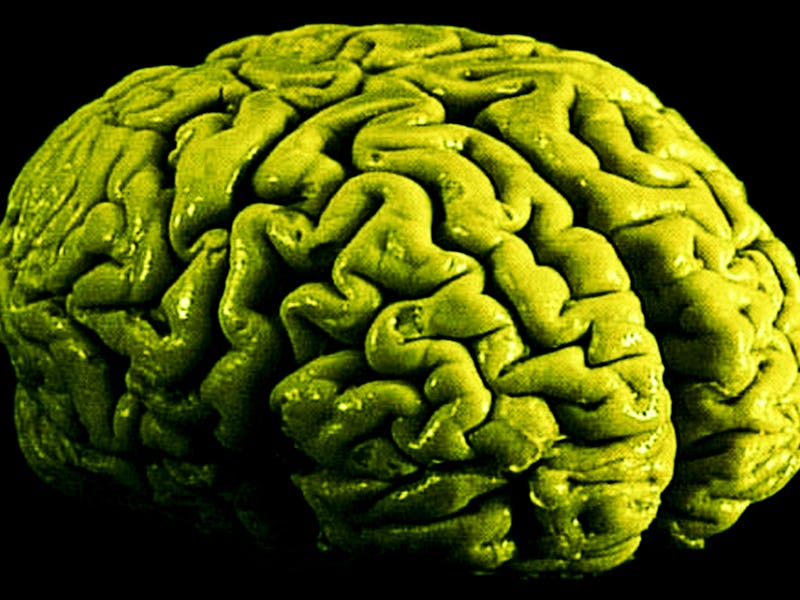Long-Term Marijuana Use Changes Brain at the Cellular Level, Say Scientists
Chronic use leads to chronic problems.

In March, long-term marijuana smoker Woody Harrelson surprised fans by announcing he was giving up his chronic pot habit, saying it made him “emotionally unavailable.” Likewise, in June, notorious stoner Miley Cyrus did the same, saying she “wanted to be really clear” while making her new album. Long-term pot smokers who have quit cite similar anecdotal evidence about the chronic effects of weed, but scientists have only recently begun understanding what, if anything, it actually does to the brain.
In a study on mice published Monday in the journal JNeurosci, scientists report that long-term marijuana use does indeed change the brain.
In their study, the researchers from Brigham Young University’s neuroscience department, led by Jeffrey Edwards Ph.D., focused on the brain’s ventral tegmental area (VTA), a region rich with the dopamine and serotonin receptors that comprise the brain’s reward system, looking at how its cells changed as the teen mice they studied received daily THC injections every day for a week. Researchers know that drugs of abuse, like opioids, alcohol, and marijuana, act on the VTA, and it’s thought that the active ingredients in these drugs stimulate the release of dopamine in this area, thereby triggering the flood of pleasure that drugs (as well as friendship and sex) provide — and creating cravings for more.
Woody Harrelson, a long-term marijuana user, said he quit because it made him emotionally unavailable.
In particular, they looked at a type of cell in the VTA known as a GABA cell that marijuana researchers hadn’t looked at before. The cells are named for the type of neurotransmitter they pick up — GABA, short for gamma-aminobutyric acid — which is well-known for its inhibitory properties. Imagine GABA as the high-strung friend who becomes anxious when the rest of the group has too much fun. When GABA is released in the brain, it regulates the levels of happy-making dopamine, making sure revelry doesn’t go overboard.
This friend is a bit of a buzzkill but seems to be necessary to prevent the brain from having too much of a good thing. But, as it turns out, GABA neurons can be incapacitated, too.
Chronic marijuana use might lead to unnaturally high dopamine levels in the brain by messing with GABA neurons.
As the researchers observed these cells in teen mice over their THC-filled week, they saw that the ability of the GABA neurons to regulate dopamine faltered as the trial went on. In contrast, mice who only received a single injection of THC — the Bill Clintons of the group — didn’t show any changes in their GABA neurons, suggesting that the effects seen in the chronic users are a consequence of long-term marijuana use. Those changes led dopamine to linger in the VTA longer than usual, which caused an abnormally drawn-out feeling of reward. And too much of those pleasurable feelings, scientists have found, is what leads to addiction.
Miley Cyrus has put her pot-smoking days behind her so her brain would be more "clear."
The team behind the study hopes that their findings can eventually be used to treat people with cannabis use disorder, defined by the Diagnostic and Statistical Manual of Mental Disorders-5 as a “problematic pattern of cannabis use leading to clinically significant impairment or distress.”
The term problematic, in this case, refers to a range of criteria largely centered around the inability of people to do what they need or want to do because of their addiction to the drug. It’s not clear whether Harrelson and Cyrus had been diagnosed with cannabis use disorder, but their reasons for quitting weed seem to line up.
Abstract:
The ventral tegmental area (VTA) is necessary for reward behavior with dopamine cells critically involved in reward signaling. Dopamine cells in turn are innervated and regulated by neighboring inhibitory GABA cells. Using whole cell electrophysiology in juvenile-adolescent GAD67-GFP male mice we examined excitatory plasticity in fluorescent VTA GABA cells. A novel CB1-dependent long-term depression (LTD) was induced in GABA cells that was dependent on metabotropic glutamate receptor 5, and cannabinoid receptor 1 (CB1). LTD was absent in CB1 knock-out mice, but preserved in heterozygous littermates. Chronic injections of Δ9-tetrahydrocannabinol occluded LTD compared to vehicle injections, however, a single exposure was insufficient to do so. Because Δ9-tetrahydrocannabinol depresses GABA cell activity, downstream dopamine cells will be disinhibited and thus this could potentially result in increased reward. As synaptic modifications by drug of abuse are often tied to addiction, this data suggest a possible mechanism for the addictive effects of Δ9-tetrahydrocannabinol in juvenile-adolescents, by potentially altering reward behavioral outcomes.
If you liked this article, check out this video about a new study that suggests weed could be used to cure Alzheimer’s.